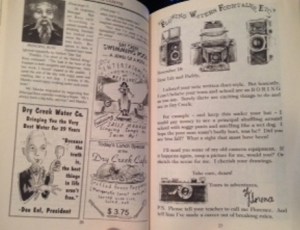I blame it on Mrs. Clarke. My fifth grade teacher opened new worlds to us-turning our room into a functioning trading post, taking us to see a traveling Broadway show, reading HARRIET THE SPY aloud with such zest that I may have filched the classroom copy to read it again over the summer. Sorry, Mrs. Clarke!
It was the first of those three that made me long to teach, the second that spurred my theatrical dreams, and the last that inspired me not only to want to read, but to be a writer of books that could grip kids the way Harriet had gripped me.
I was already an avid reader. It was the way Mrs. Clarke read aloud that really connected me to that book and the power of good writing. I’ll never forget when my teacher shouted “FINKS!” a la Harriet with such passion. It was as if the middle-aged woman who taught us dry subjects like math and spelling had been transformed into a conflicted girl who was neglected by her parents and misunderstood by her friends. I was addicted.
“The reading” is one of my favorite parts of school visits and book signings. It doesn’t matter how self-conscious I feel standing up in front of a crowd, the second I start to read and become the characters on the page, all of that lifts. I happily make a fool out of myself, morphing into a lisping, retainer-wearing bully or an evil genius toddler for the reward of giggles or hearing a student cry, “Don’t stop!” when I close the book.
Whether you’re a parent, teacher, librarian, or an author, employing some of these simple techniques can enhance the read aloud experience for you and your listeners.
When Possible, Practice Aloud Ahead of Time This is the single most helpful thing you can do to improve your reading. While not always practical for teachers or parents reading aloud a chapter a day, even having read the material once will improve your chances of not tripping over difficult phrases and knowing where to pause and change voices. Before I have a school visit, I always rehearse the material several times, highlighting pauses and character changes. I forgot my reading glasses at my first book’s launch, and having rehearsed so much saved me some serious embarrassment!
Ba-Dum-Ching! Build tension by pausing at ellipses and speeding up during action scenes. When reading funny material, comedic timing is essential. If you’re not certain how comedic rhythm works, study funny plays and listen for those moments when the actors pause and how they deliver punch lines. I use dramatic pauses and ba-dum-ching! moments to give the audience a significant glance, drawing them into the moment.
Eye Contact Speaking of significant glances: use your finger to keep your place in the text so you can look at your listeners occasionally. It will do wonders to keep them engaged. Here practicing ahead is especially helpful.
Animate Your Body and Face A gesture now and then keeps things exciting for your audience. When I’m reading from my TODD books, I like to wave around a “dirty” sock when I’m doing those portions. If I’m especially familiar with a passage I will walk back and forth, depending on the crowd size and location (I’ve been known to nearly fall off of stages-so use caution.)
I try to animate my face when I read, within reason. There’s no need to channel Jim Carrey, but do try to be entertaining if the text calls for it.
Be Heard If your voice is naturally soft, use a microphone in larger settings or practice projecting by breathing from your diaphragm muscle rather than just your chest. Pop your consonants and don’t drop the end of your sentences, letting them trail off.
Put Your Heart Into It Even if you’re reading a passage that is more contemplative and doesn’t require as much animation, be sensitive to the nuances of the prose and dialogue. There are times when “less is more” while reading aloud, and being subtle is the best method. But whatever you’re reading, your listeners will know right away whether or not you’re wholly invested in the material. If you are, be prepared to be begged for more!
Can you think of any techniques I might have left out? What are your favorite books to read aloud? Any childhood memories of being read to that impacted your love of literature?
 Louise Galveston is the author of BY THE GRACE OF TODD and the newly released IN TODD WE TRUST, both from Penguin/Razorbill. She directs children’s and community theater and tweets @LouiseGalveston. Find out more about Louise and her work at www.bythegraceoftodd.com.
Louise Galveston is the author of BY THE GRACE OF TODD and the newly released IN TODD WE TRUST, both from Penguin/Razorbill. She directs children’s and community theater and tweets @LouiseGalveston. Find out more about Louise and her work at www.bythegraceoftodd.com.





















